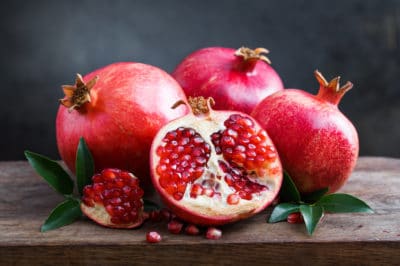Pomegranate Basics
The pomegranate is a thick-skinned fruit – actually a type of berry – with multiple fleshy cells that contain seeds and sweet-tart red or pink flesh. Native to Iran – the ancient country of Persia – pomegranates can easily be grown in USDA Zones 8 to 10. You can also grow container plants in colder regions and move them indoors for the winter.
The US Pomegranate Harvest
Most commercial pomegranates in the US are grown in California. The counties of Tulare, Kern, Fresno, imperial and Riverside produce most of the fruit. Wonderful is the most common commercial variety, although Granada is also becoming popular. These fruits are typically available from October through January.
Imported Pomegranate Season
Many of the countries that grow pomegranates commercially are located in the Southern Hemisphere and have a season that is the opposite of the season in the US. India is the world’s largest commercial pomegranate producer. Growers in India focus on six varieties: Ganesh, Mridula, Arakta, Ruby, Phule Bhagwa, and Phule Bhagwa Super. These are available from March to May.
Growing Your Own
If you live in the right climate, it’s easy to grow pomegranates. Outside the warm regions they prefer, you can still grow them in containers or even indoors. Any soil is fine as long as it drains well – even heavy clay will work if amended with coarse sand. Pomegranates are drought-tolerant but produce better if watered weekly in dry climates. Use an organic mulch to promote fertility.
Choosing Pomegranate Varieties
Growing your own means you have many more choices. These varieties are easily found in nurseries and from specialty suppliers:
- Wonderful – ripens in September.
- Early Wonderful – blooms later but ripens two weeks ahead of Wonderful.
- Granada – ripens in August.
- Emek – Israeli variety, ripens in July.
- Valenciana – Spanish variety, ripens in August.
Extending the Season
In addition to choosing varieties that mature at different times, you have a couple of options to extend the pomegranate season. Even if you live in a pomegranate-friendly climate, you can plant some smaller varieties in containers and move them indoors in fall – pomegranates will continue to flower as long as they have enough light. You can also grow them in a sun-room or greenhouse.
Storing Pomegranates
Although the actual season for fresh pomegranates is relatively short compared to some fruits, you can extend it by proper storage. Fruit with intact rinds can be stored in the refrigerator for three to four weeks. The arils can be frozen for up to a year. Fresh seeded pomegranate should be eaten within two or three days.
